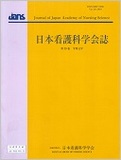Japanese
English
- 販売していません
- Abstract 文献概要
- 参考文献 Reference
- サイト内被引用 Cited by
要旨
目的:高齢者ケアの継続に向けた急性期病院看護師のコーディネート機能を明らかにする.
方法:看護師16 名を対象に半構成的面接を行い質的統合法(KJ法)にて分析した.
結果:コーディネート機能は,【他職種を含めたケア実践への動力:日頃の関わりから高齢者の望みや価値観を感性で捉え支える】,【他職種との連携・調整への動力:多角的視点での情報収集・現状判断と予測からの舵取り】,【高齢者の生き様を尊重したケア実践に向けた足固め:高齢者の全体像やケアの方向性一致・集約への働きかけ】,【よりよい連携に向けた足固め:互いの専門性の尊重と担当領域の見定め】,【高齢者をとりまく環境に対する調整:介護者へのケアや関係調整,地域住民への啓発】,【システム環境に対する調整:伝達をスムーズにする為の手段やルートの構築】の6機能であった.
結論:コーディネート機能は「足固め−動力−調整」と「高齢者−他職種」からなる2軸構造となった.
Aim: This study aimed to identify actions that nurses take in acute care hospital settings to continue with care for elderly people.
Method: Sixteen nurses participated in semi-structured interviews. Interview data were analyzed using a qualitative synthesis method (KJ method) and then organized into groups representing the targeted nursing actions.
Results: The following six actions were extracted from the interview data. 1) Encourage your healthcare professional team to pay attention to elderly people's hopes or values based on their everyday interactions. 2) Encourage collaboration between healthcare professionals by sharing information about elderly people from multiple perspectives and discussing possible treatments. 3) Gain a foothold for elderly care by respecting their own way of living and ensuring other healthcare professionals consider elderly people as human beings. 4) Gain a foothold for healthcare professionals' work by respecting individual specialties and determining their area of responsibility. 5) Control the environment around elderly people by supporting caregivers, adjusting the relationship between an elderly person and his/her caregiver and informing general citizens. 6) Control the environment around healthcare professionals by creating a system to communicate smoothly.
Conclusions: Actions 1) and 2) represent “Encouraging”, actions 3) and 4) represent “Gaining a foothold” and actions 5) and 6) represent “Controlling the environment”. Furthermore, actions 1), 3) and 5) targeted elderly people and actions 2), 4) and 6) targeted healthcare professionals. Therefore, we found two axes of nursing actions: “Encouraging—Gaining a foothold—Controlling the environment” and “Elderly people—Healthcare professionals”.
Copyright © 2019, Japan Academy of Nursing Science. All rights reserved.


